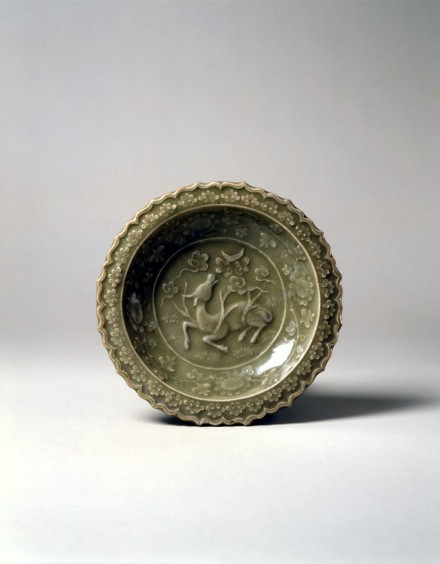J.J. Lally & Co., Oriental Art / New York City, New York
MenuPast Exhibition
Chinese Ceramics A.D. 400–1400:
Selections from an American Collection
March 19 - 31, 2007

24.
A MOULDED LONGQUAN CELADON DISH WITH XINIU
Yuan Dynasty, A.D. mid 14th Century
of shallow circular form with bracket-lobed edge around the thick everted rim, finely moulded in the central medallion with a xiniu, the single-horned mythical beast with bovine body shown with tongues of flame rising from its flanks, reclining on a grassy bank and gazing up at a crescent moon amidst drifting puffy clouds, the cavetto moulded with a continuous band of chrysanthemum scroll bearing four large blooms, the rim with a moulded border of thirty-two florets, the underside plain, covered with a glossy translucent olive green glaze continuing over the wide ring foot, the recessed base with a splash of glaze in the center, the exposed stoneware burnt to tan brown in the firing.
Diameter 5 3⁄4 inches (14.6 cm)
A very similar Longquan celadon dish moulded with this rare design in the Art Institute of Chicago, from the Lucy Maud Buckingham Collection, is illustrated by Lee and Ho, Chinese Art Under the Mongols: The Yuan Dynasty (1279-1368), Cleveland, 1968, no. 68 and the same dish is illustrated by Mino and Tsiang, Ice and Green Clouds: Traditions of Chinese Celadon, Indianapolis, 1986, no. 86, pp. 210-211. Another Longquan dish of this design in the Asian Art Museum of San Francisco is illustrated by He, Chinese Ceramics: The New Standard Guide, San Francisco, 1996, no. 509, p. 246.
The design of a xiniu gazing at the moon appears for the first time in the Song dynasty and remains popular through the 13th and 14th centuries, appearing on Dingyao and Yaozhou bowls and dishes as well as textiles and elsewhere in the Chinese decorative arts. The theme is discussed at length by Wirgin, “Sung Ceramic Designs,” B.M.F.E.A., No. 42, Stockholm, 1970, pp. 196-198. According to Wirgin the term hsi-niu meant rhinoceros in ancient Chinese texts, but the rhinoceros became extinct in the post-archaic period, and by the Song dynasty the xiniu had become a beast of legend, known only through literary references. The design of a xiniu gazing at a crescent moon in Song and Yuan ceramics illustrates the popular myth that the unique crescent-shaped horn of the rhinoceros shows the beast magically “communicating with the sky” through its horn. The magical powers attributed to the horn of the rhinoceros in the Song dynasty continued to gain in complexity and popularity in later periods. Supernatural, medicinal and other valuable properties were attributed to the rhinoceros horn by Daoist adepts and medicine men, including the reputation for powerful effect as an aphrodisiac. This lead to the production of rhinoceros horn bowls and cups, a category of decorative art unique to China, which flourished in the late Ming and throughout the Qing dynasty.
24.
A MOULDED LONGQUAN CELADON DISH WITH XINIU
Yuan Dynasty, A.D. mid 14th Century
Diameter 5 3⁄4 inches (14.6 cm)